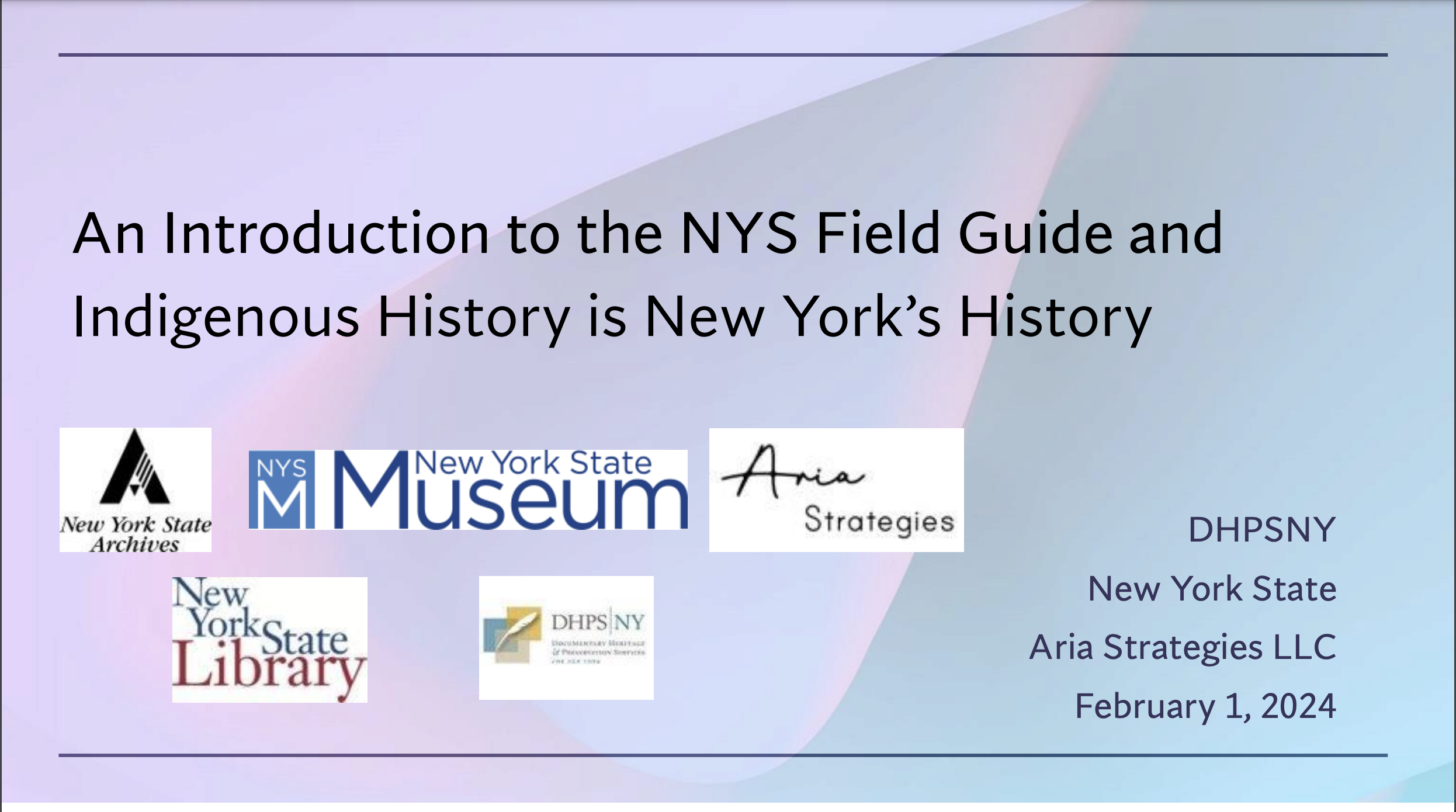Translate
Antiracism Resources: Indigenous History is New York’s History

Written by DHPSNY Dialogue co-facillitaor Aria Camaione-Lind, Principal & CEO, Aria Strategies LLC
On February 1, we kicked off our 2024 antiracism Dialogue series with a program to introduce the 250th commemoration field guides from AASLH and APHNYS/Office of the New York State Historian: Building an Inclusive 250th: An Introduction to the NYS Field Guide and Indigenous History is New York’s History. Our co-facilitators, Scott Manning Stevens (Syracuse University), Devin Lander (NYS Historian), and John Diefenderfer (Archival Advisory Services, New York State Archives) helped us answer the question: How do we make our collecting organizations interdisciplinary and representative of the realities of our many New York histories? This program invited participants to grapple with Indigenous history and (historic/contemporary) experiences of Indigenous people and communities as an opportunity for organizations facilitating difficult and necessary conversations about their site’s and collection’s relationship to Indigenous communities in what is now New York State.
Devin Lander kicked off our program by introducing the New York State Association of Public Historians/Office of the State Historian-produced 250th commemoration field guide. He oriented us to the very first theme: Indigenous history is New York State history and the imperative to include authentic - actual - Indigenous experience in our organizations’ plans for the commemoration. You can review the field guide here.
Scott Manning Stevens grounded us in place as an important point to begin how we understand Indigenous history as New York history. He encouraged us to interrogate: What is this place’s history? Who were the original inhabitants? Where are their descendants now? He also reminded us that New York State’s shape closely mirrors the shape of the Haudenosaunee Confederacy and our state is home to many reservations or territories. Scott also suggested resources where we, as professionals and volunteers in the field, can continue to learn about both the Indigenous past and the Indigenous present in what is now New York State.
Finally, John Diefenderfer encouraged us to look for Indigenous stories and experiences even if we can’t immediately identify a tie-in to the Indigenous community. He suggested identifying objects and documents in our collections that we can “read against the grain” to better understand our collections' (and organizations’) relationship to actual Indigenous experiences and using those new interpretations to commemorate the 250th.
How often does your organization strive for “authentic/actual Indigenous experience”? What does it look like when you are getting close to (what you consider) “doing it right”? How can or do you use the location of your collection or historic site to tell Indigenous stories – both historical and 21st century? How have you read archives and/or collections “against the grain” to understand the multiple people affected by a document or piece of material culture? You can reach us by email at info@DHPSNY.org, or connect with us on the DHPSNY Facebook page or DHPSNY Community Facebook Group.
Click here for the recording.
Click here to download the slideshow.
If you attended this event, we'd love to hear your feedback to help improve future programming by completing this survey.
Resources for further study:
Akwesasne Cultural Center. https://akwesasneculturalcenter.org/
A New York Minute in History. Podcast. https://wamcpodcasts.org/a-new-york-minute-in-history/
Blackhawk, Ned. The Rediscovery of America: Native Peoples and the Unmaking of U.S. History. 2023.
Ganondagan State Historic Site.https://ganondagan.org/
Iroquois Museum. https://www.iroquoismuseum.org/
Koch, Daniel. Land of the Oneidas: Central New York State and the Creation of America, from Prehistory to the Present. 2023.
Lonetree, Amy. Decolonizing Museums: Representing Native America in National and Tribal Museums. 2012.
National Museum of the American Indian (New York). Native New York. https://americanindian.si.edu/explore/exhibitions/item?id=981
The New York State 250th Commemoration Field Guide. https://www.nysm.nysed.gov/sites/default/files/nys_250_commemoration_fie...
New York State Archives: Digital Collections. https://digitalcollections.archives.nysed.gov/index.php
New York State Library: Native American Materials. https://www.nysl.nysed.gov/scandocs/nativeamerican.htm
Oberg, Michael Leroy and Peter Jakob Olsen-Harbich. Native America: A History, 3rd edition. 2022.
Oneida Shako:wi Cultural Center. https://www.oneidaindiannation.com/shakowiculturalcenter/
Skä·nonh – Great Law of Peace Center. https://www.skanonhcenter.org/
Sleeper-Smith, Susan (ed.) et al, Why You Can’t Teach United States History without American Indians. 2015.
Society of American Archivists. Protocols for Native American Archival Materials. https://www2.archivists.org/groups/native-american-archives-section/protocols-for-native-american-archival-materials-information-and-resources-page
This post is part of a blog series on sharing information, promoting resources, encouraging discussion, and amplifying the voices of Black, Indigenous, and People of Color (BIPOC) doing antiracism work in archives, museums, history sites, and library special collections. DHPSNY is committed to supporting the diverse network of collecting institutions that safeguard and ensure access to historical records and library research materials across New York State. To learn more, visit our first blog post in the series.
To access the full list of resources in this series, visit our Antiracism Resources links spreadsheet.